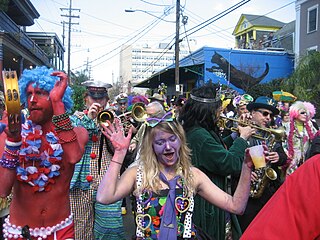
Mardi Gras is the final day of Carnival or Shrovetide before Ash Wednesday. Mardi Gras is French for "Fat Tuesday", reflecting the practice of the last night of consuming rich, fatty foods in preparation for the fasting season of Lent.

Carnival or Shrovetide is a Christian festive season that occurs before Lent, consisting of Quinquagesima or Shrove Sunday, Shrove Monday, and Shrove Tuesday or Mardi Gras.

The festival of San Fermín is a week-long, historically rooted celebration held annually in the city of Pamplona, Navarre, Spain. The celebrations start at noon on 6 July and continue until midnight on 14 July. A firework (Chupinazo) starts off the celebrations and the popular song Pobre de mí is sung at the end. The most famous event is the running of the bulls, which begins at 8 a.m. each day on 7–14 July, but the festival involves many other traditional and folkloric events. It is known locally as Sanfermines in Spanish and Sanferminak in Basque, and is held in honour of Saint Fermin, the co-patron of Navarre.

Soule is a former viscounty and French province and part of the present-day Pyrénées-Atlantiques département. It is divided into two cantons of the arrondissement (district) of Oloron-Sainte-Marie, and a part of the canton of Saint Palais.

The term maracatu denotes any of several performance genres found in Pernambuco, Northeastern Brazil. Main types of maracatu include maracatu nação and maracatu rural.

The Trinidad and Tobago Carnival is an annual event held on the Monday and Tuesday before Ash Wednesday in Trinidad and Tobago. This event is well known for participants' colorful costumes and exuberant celebrations. There are numerous cultural events such as "band launch fetes" running in the lead up to the street parade on Carnival Monday and Tuesday. It is said that if the islanders are not celebrating it, then they are preparing for it, while reminiscing about the past year's festival. Traditionally, the festival is associated with calypso music, with its origins formulated in the midst of hardship for enslaved West and Central Africans; however, recently Soca music has replaced calypso as the most celebrated type of music. Costumes, stick-fighting and limbo competitions are also important components of the festival.
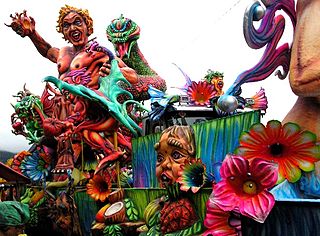
Blacks and Whites' Carnival, is the largest and most important festival in southern Colombia. Although its geographical location belongs to the city of Pasto, it has been adopted by other municipalities in Nariño and southwestern Colombia. It is celebrated every year in 2–7 January and attracts a considerable number of Colombian and foreign tourists.

The Barranquilla Carnival is one of Colombia's most important folkloric celebrations, and one of the biggest carnivals in the world. The carnival has traditions that date back to the 19th century. Four days before Lent, Barranquilla decks itself out to receive national and foreign tourists to join together with the city's inhabitants to enjoy four days of intense festivities. During the carnival, Barranquilla's normal activities are put aside as the city gets busy with street dances, musical and masquerade parades. The Carnival Of Barranquilla includes dances such as the Spanish paleo, African Congo, and indigenous mice y mica's. Many styles of Colombian music are also performed, most prominently cumbia, and instruments include drums and wind ensembles. The Carnival of Barranquilla was proclaimed a Cultural Masterpiece of the Nation by Colombia's National Congress in 2002. Also the UNESCO, in Paris on November 7, 2003, declared it one of the Masterpieces of the Oral and Intangible Heritage of Humanity, and it was during Olga Lucia Rodriquez Carnival Queen year.
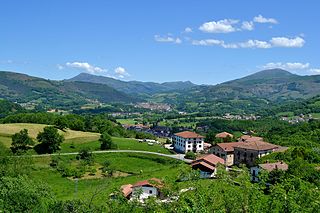
Baztan is a municipality from the Chartered Community of Navarre, northern Spain. It is located 58 km (36 mi) from Pamplona, the capital of Navarre. It is the largest municipality in Navarre, with around 376.8 km2 and just over 8,000 inhabitants.
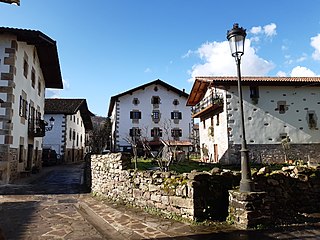
Ituren is a town and municipality located in the province and autonomous community of Navarre, northern Spain. Ituren sits on a westernmost outlying area of the Pyrenees, 56.5 km north of Pamplona. It lies on the flood plain of the River Ezkurra, a tributary of the River Bidasoa, in the shadow of the Mendaur mountain which is characterised by the tiny white-washed chapel of La Trinidad, on its summit.

The Swabian-Alemannic Fastnacht, Fasnacht or Fasnat/Faschnat is the pre-Lenten carnival of Alemannic folklore in Switzerland, southern Germany, Alsace and Vorarlberg.

The West Country Carnival Circuits are an annual celebration featuring a parade of illuminated carts in the English West Country. The celebration dates back to the Gunpowder Plot of 1605. The purpose is to raise money for local charities.
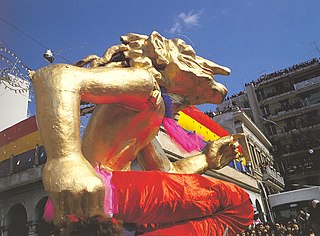
The Patras Carnival, or Patrino karnavali, is the largest event of its kind in Greece. It has more than 180 years of history. The events begin on 17 January and last up to Clean Monday. The carnival of Patras is not a single event but a variety of events that includes balls, parades, hidden treasure hunt and the children's carnival amongst others. It climaxes in the last weekend of Carnival with the Saturday evening parade of carnival groups, the extravagant Sunday parade of floats and groups, and finally the ritual burning of the carnival king at the St. Nikolaos Street pier in the harbour of Patras. Its characteristics are spontaneity, improvisation, inspiration and volunteerism. In 2019, there were about 750.000 participants in the carnival
Chanté mas and Lapo kabrit is a form of Carnival music of Dominica. It is performed by masquerading partygoers in a two-day parade, with a lead vocalist (chantwèl), who is followed by the responsorial chorus (lavwa), with drummers and dancers dancing backwards in front of the drummer on a tambou lélé. The Carnival has African and French roots and is otherwise known as Mas Dominik, the most original Carnival in the Caribbean.

Mardi Gras is the annual Carnival celebration in Mobile, Alabama. It is the oldest official Carnival celebration in the United States, started by Frenchman Nicholas Langlois in 1703 when Mobile was the capital of Louisiana. Although today New Orleans and South Louisiana celebrations are much more widely known for all the current traditions such as masked balls, parades, floats and throws were first created there. From Mobile being the first capital of French Louisiana (1702), the festival began as a French Catholic tradition. Mardi Gras has now evolved into a mainstream multi-week celebration across the spectrum of cultures, becoming school holidays for the final Monday and Tuesday, regardless of religious affiliation.

The Carnival of La Bañeza, in the province of Leon, is a festival declared of national tourist interest that began to gain importance and fame at the beginning of the 20th century during the repression under Franco, due to the prohibition of concealing one's face or wearing a costume. The main characteristic of La Bañeza's carnival is the absence of a costume competition with prizes and monetary compensation for participating, which may occur in carnivals elsewhere. Most of the city dedicates themselves wholeheartedly to the festival, passing on interest through generations. In many cases, participants prepare a year in advance, searching for accessories, fabrics, masks and acts they will perform, motivated by a "carnival feeling", lived during those days. Given this, the disorganized carnival is becoming increasingly popular, dressing up outside of parade hours, or on days without events, in the workplace, etc. looking to surprise and amaze the citizens and visitors.

The Carnival in the Dominican Republic is a Dominican celebration that takes place throughout February, and sometimes during Holy Week in March. Dominican Carnival is celebrated in most cities and towns in the main streets. The carnival season in the Dominican Republic kicks off with a carnival gala held indoors in Santiago de los Caballeros, as opposed to every other carnival event held outdoors throughout the month of February. Among its main characteristics are its flashy costumes and loud music. The one held in La Vega, which is one of the biggest in the country, and the national parade in Santo Domingo, were the first Carnivals held in the Americas.
Carnivals in the Basque Country are celebrated in eleven different villages and cities and they are usually lively and colourful celebrations. This way of celebrating carnivals has attracted attention all over Europe. They are associated with the old tradition of the Basque Country and they have been celebrated in different ways since the age of the Roman Empire. Each village or city has a typical character and all the celebrations are associated with this character. They have had a lot of changes during the years in the costumes, rituals, meanings and ways to celebrate them. They have been also denounced several times, for example by Franco's dictatorship. But they always have been a very important part of the basque culture and it is also a symbol of it.

The Carnival of Cayenne is an annual event held in Cayenne, French Guiana. Alongside the Kourou Carnival and the Saint-Laurent Carnival, it is one of the most significant carnivals in the region.

Xanthi Carnival and Thracian Folk Festival is the biggest event of its kind in northern Greece and the second biggest in Greece, following the Patras Carnival. Ιt was founded in 1966, in a formal way. The event is held annually under the auspices of the Cultural Center of the Municipality of Xanthi.






















